NLX Retro Computer
In the nineties, there were a lot of manufacturers in the computer market, a lot of formats and a lot of attempts to make a new standard for something. Usually it turned out like on that caricature .
About a year ago, I got a computer somewhere in the late nineties in a very compact package. This is not the first compact computer of those times that I meet, but it was the first meeting with the NLX form factor - an attempt to create a new standard for compact cases.

I'll tell you a little about the format, and then about the computer itself.
The predecessor of NLX was the LPX format - Low Profile Extended. It was originally proposed by Western Digital, accepted by manufacturers, but not officially issued. As a rule, the dimensions of the motherboard were 300x229mm (13x9 inches), the I / O controllers were integrated - not the most common solution for the mass market in the early and mid-nineties, the expansion slots were on the riser card, and the motherboard was compatible with AT in power supply.
Motherboard LPX:


LPX Riser Card:

LPX case with motherboard ( from here ).
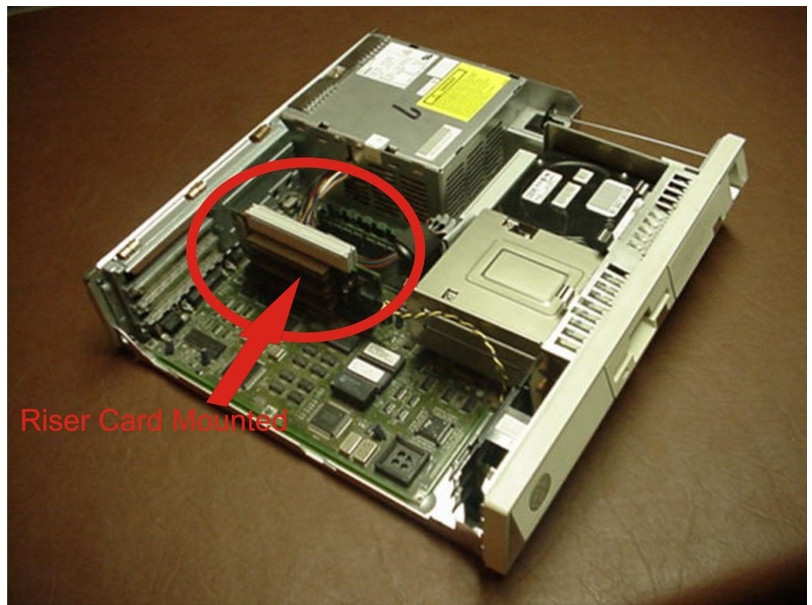
When the Pentium II processors in the slot version came out, it became clear that it would be difficult to put them in the LPX. And with the place of the problem - given the riser in the middle of the board, and with ventilation. Because smart people from Intel, IBM, DEC, etc. decided to develop a full-fledged standard for replacing LPX. And originally called it New Low Profile eXtended, or NLX.
In two years from 1997 to 1999, several revisions of the standard were developed, from 1.2 to 1.8, because everything changed very quickly. Implementation of AGP, ATX power supplies, Intel's return to sockets from slots ... Description of NLX version 1.8 .
The main idea was the transfer from the center of the riser card to the right side of the motherboard, as well as the removal of expansion slots on it - in order to turn the motherboard itself into something like an expansion card, so that it can be changed without disconnecting the peripherals.
It was proposed to leave I / O ports on the motherboard, as in LPX, as well as the processor, memory and controllers on the motherboard. And all the internal connectors and expansion slots (PCI, ISA) were transferred to the riser card.

If you look from above, it should look something like this - everything connects to the riser, including the power supply.

And this is a more detailed view of the riser card from the motherboard. Below is a long slot, into which the same long connector was stuck from the edge of the motherboard, and on the riser itself there were already expansion slots and all internal connectors - buttons, indicators, data storage devices.

If you want more details, then I gave a link to the format description above.
Motherboard NLX Socket 7 (IBM Socket7 IKCN74000227 NLX Motherboard 681127-204 - 681127-204)

Obviously a late motherboard, with Socket 370 and even with an AGP slot. It was not provided on the riser card, so I had to stick it on the other side of the motherboard. At the same time, a newer case was clearly needed for its use, because in the earlier cases there was also no space for an expansion card on this side.

Riser Card:
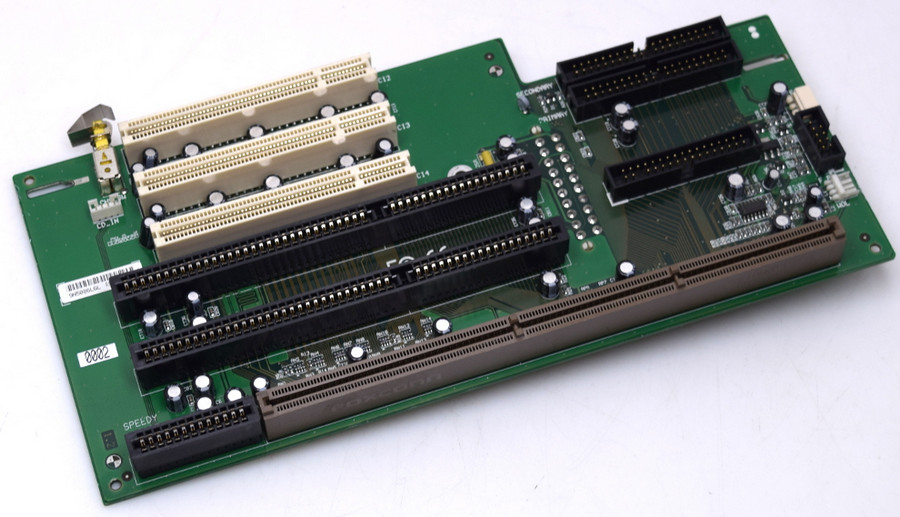
IBM's “full-size” NLX package. From here .


You can see where it was proposed to put the AGP-board. But it had to be a specially trained board, "mirror" relative to the standard.

On YouTube there is a good review of the late NLX standard computer - Socket 370, all on latches, it is very simple and quick to disassemble.
It did not take off for two main reasons, as it seems to me. Firstly, the largest manufacturers (such as Dell) did not accept the standard and used their proprietary standards. Secondly, as I already said, in those days constantly something new was invented and the standard simply could not keep up with all the innovations. Variations ATX were much more flexible and tenacious.
Coming back to my computer. To the top. The lower one has not yet switched to retro, where the Pentium D is a very relevant machine.

TTX
Processor: Pentium III EB 1000 @ 750. Downlock is not from a good life, but from the BX-chipset, which in the case of a heap of integrated iron is hard to chase, but officially only works at 100 MHz on the bus.
RAM: 512 megabytes SDRAM DIMM, 2 * 256. Purely theoretically, the chipset holds gigabytes, but I don’t have 512 dimmons that start here. Available - do not work.
Video card: built-in ATI 3D Rage Pro Turbo 8MB, hanging on AGP.
Sound card: built-in ESS Solo-1 1938.
Data storage: Hard drive 80GB IDE, optical drive - laptop DVD-RW Phillips some there.
Operating System: Windows 98SE. XP is possible, but why?
The standard itself is still clearly in its early performance - you can compare it with the Gateway from the video above.
Ahead - a drive, an optical drive, buttons - including volume control, a couple of USB ports, audio connectors and an infrared window. Just a window, the port itself is not wired.

At the back you can see a couple of expansion slots and integrated ports. PS / 2, COM, LPT, VGA, network, two USB and sound.

The insides. Compared to Gateway, there are a lot of cables.

The motherboard itself is still without cables, the principle of connecting everything to the riser is respected. But it is screwed directly to the bottom of the case, no retractable pallets.
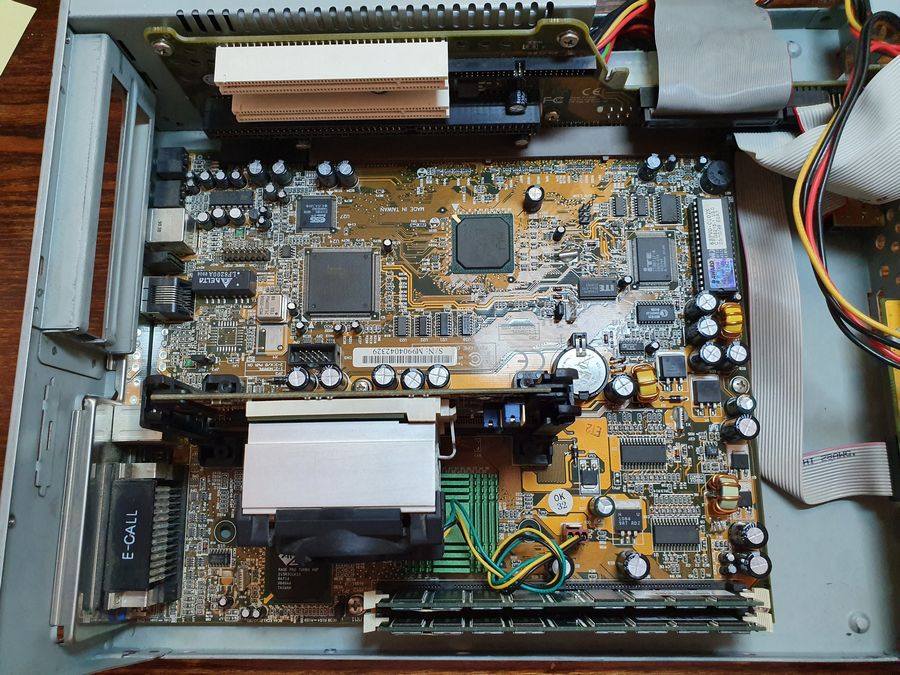
Riser. Two PCI, one combined with ISA, a connector for a laptop optical drive, a standard IDE and a slightly off-screen drive connector.
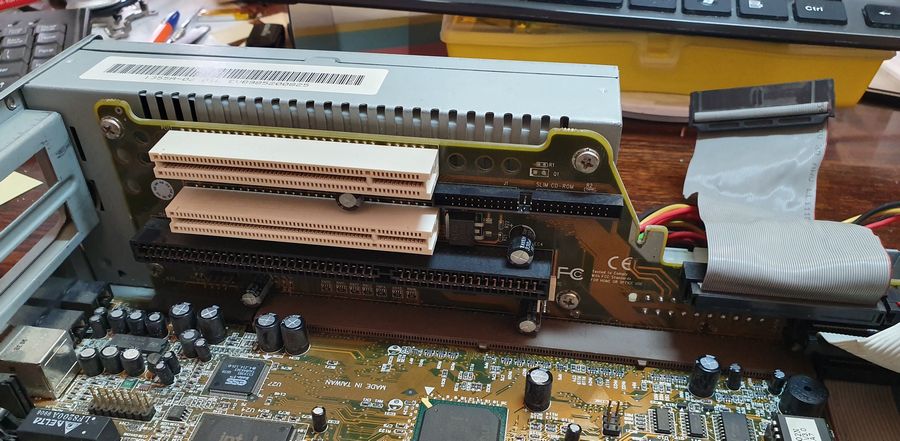
A power supply unit with a standard ATX connector is also connected to the riser.

Mounting drives. The hard drive is at the bottom, there is only one place.
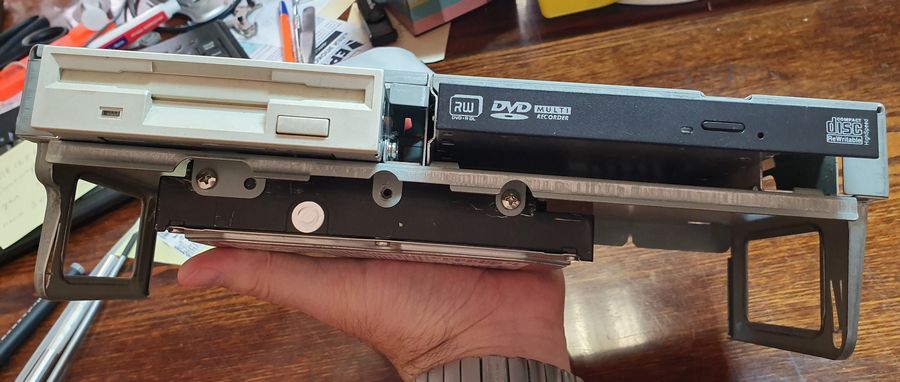
Installed in the housing. Above USB you can see the place where the infrared port should be. It is even drawn on the board, not simply soldered.

I have a habit of trying to maximize the upgrade of all computers with which I constantly deal. With modern ones, this does not always work, because there is a maximum unattainable without serious costs, and with old cars this is quite possible due to the fact that they are limited from above and this limit is often achievable for a small amount. Well, or if it is expensive, then you can put a "maximum minus one", the performance difference is minimal, but the price can be several times.
In this computer, first of all, the video card did not suit. Firstly, even in current times about Rage Pro, only lazy ones did not wipe their feet. In quake3, 800x600 / 32 bits - 10 frames per second. Secondly, problems with dosovskih games. It even perverted Starcon2:

At first I thought about putting a 3D accelerator, fortunately I have a couple of Voodoo2, but, firstly, there is not enough space - I would have to cut the case.

Secondly, I still wanted to get a digital output - DVI or HDMI. Well and thirdly, look at Starcon2. You can’t do that.
So you had to look for a decent graphics card for PCI. The best option, of course, would be some kind of Voodoo3-5 on PCI, but it was tight with DVI, and the price is not good, they are already considered antiques and can easily break a few hundred dollars - especially for PCI options.
Having sorted out authentic and not so options, as a result settled on Geforce FX5500 PCI. The Chinese are still releasing them, there will be enough performance for the eyes and ears, the drivers are for all the OSs of those years except maybe 3.1, but there you can use the standard SVGA.
I will not describe the purchase itself, I already did it on mysku .

As a result, everything started up successfully, the starcon got its original color, and quake3 showed 66 fps.
Of all the PCI sound cards, the ESS Solo-1 built-in here is perhaps one of the most trouble-free in terms of working under pure DOS - just load the driver. But it only works like Sound Blaster Pro, and I also wanted to have some kind of MIDI, and not do just FM synthesis.
Of course, I have AWE32, but it will not fit here from the word at all:

I also have a Monster Sound MX300 and ESS1868 - you can attach a daughterboard with WaveTable to them. But I don’t have a daughterboard yet, although I’m thinking of some kind of DreamBlaster - it’s not very cheap, but it’s easy to find on sale, unlike authentic modules. But it does not burn.
As a result, the question was resolved by itself - in the aforementioned review of the FX5500, I complained that AWE32 does not climb and I want AWE64 - and they presented it to me. Of course, for complete happiness I would like Gold, but I don’t look at the gift horse. And so it turned out well. But very crowded.

In principle, you can try to find a more powerful processor - either coppermine on the 100th bus, or try to re-solder the toilet, I have the Celeron 1300 lying around.
Still, if there was a desire to make this computer the main retro-machine, then it would be possible to replace the hard drive with some kind of flash drive, and instead of a drive put an emulator. But so far I have not decided yet - there is a Dell systematic that I want to use as such.
But this one will lie on the shelf as a piece of history.
About a year ago, I got a computer somewhere in the late nineties in a very compact package. This is not the first compact computer of those times that I meet, but it was the first meeting with the NLX form factor - an attempt to create a new standard for compact cases.

I'll tell you a little about the format, and then about the computer itself.
LPX
The predecessor of NLX was the LPX format - Low Profile Extended. It was originally proposed by Western Digital, accepted by manufacturers, but not officially issued. As a rule, the dimensions of the motherboard were 300x229mm (13x9 inches), the I / O controllers were integrated - not the most common solution for the mass market in the early and mid-nineties, the expansion slots were on the riser card, and the motherboard was compatible with AT in power supply.
Motherboard LPX:


LPX Riser Card:

LPX case with motherboard ( from here ).

Nlx
When the Pentium II processors in the slot version came out, it became clear that it would be difficult to put them in the LPX. And with the place of the problem - given the riser in the middle of the board, and with ventilation. Because smart people from Intel, IBM, DEC, etc. decided to develop a full-fledged standard for replacing LPX. And originally called it New Low Profile eXtended, or NLX.
In two years from 1997 to 1999, several revisions of the standard were developed, from 1.2 to 1.8, because everything changed very quickly. Implementation of AGP, ATX power supplies, Intel's return to sockets from slots ... Description of NLX version 1.8 .
The main idea was the transfer from the center of the riser card to the right side of the motherboard, as well as the removal of expansion slots on it - in order to turn the motherboard itself into something like an expansion card, so that it can be changed without disconnecting the peripherals.
It was proposed to leave I / O ports on the motherboard, as in LPX, as well as the processor, memory and controllers on the motherboard. And all the internal connectors and expansion slots (PCI, ISA) were transferred to the riser card.

If you look from above, it should look something like this - everything connects to the riser, including the power supply.

And this is a more detailed view of the riser card from the motherboard. Below is a long slot, into which the same long connector was stuck from the edge of the motherboard, and on the riser itself there were already expansion slots and all internal connectors - buttons, indicators, data storage devices.

If you want more details, then I gave a link to the format description above.
Motherboard NLX Socket 7 (IBM Socket7 IKCN74000227 NLX Motherboard 681127-204 - 681127-204)

Obviously a late motherboard, with Socket 370 and even with an AGP slot. It was not provided on the riser card, so I had to stick it on the other side of the motherboard. At the same time, a newer case was clearly needed for its use, because in the earlier cases there was also no space for an expansion card on this side.

Riser Card:

IBM's “full-size” NLX package. From here .


You can see where it was proposed to put the AGP-board. But it had to be a specially trained board, "mirror" relative to the standard.

On YouTube there is a good review of the late NLX standard computer - Socket 370, all on latches, it is very simple and quick to disassemble.
It did not take off for two main reasons, as it seems to me. Firstly, the largest manufacturers (such as Dell) did not accept the standard and used their proprietary standards. Secondly, as I already said, in those days constantly something new was invented and the standard simply could not keep up with all the innovations. Variations ATX were much more flexible and tenacious.
A computer
Coming back to my computer. To the top. The lower one has not yet switched to retro, where the Pentium D is a very relevant machine.

TTX
Processor: Pentium III EB 1000 @ 750. Downlock is not from a good life, but from the BX-chipset, which in the case of a heap of integrated iron is hard to chase, but officially only works at 100 MHz on the bus.
RAM: 512 megabytes SDRAM DIMM, 2 * 256. Purely theoretically, the chipset holds gigabytes, but I don’t have 512 dimmons that start here. Available - do not work.
Video card: built-in ATI 3D Rage Pro Turbo 8MB, hanging on AGP.
Sound card: built-in ESS Solo-1 1938.
Data storage: Hard drive 80GB IDE, optical drive - laptop DVD-RW Phillips some there.
Operating System: Windows 98SE. XP is possible, but why?
The standard itself is still clearly in its early performance - you can compare it with the Gateway from the video above.
Ahead - a drive, an optical drive, buttons - including volume control, a couple of USB ports, audio connectors and an infrared window. Just a window, the port itself is not wired.

At the back you can see a couple of expansion slots and integrated ports. PS / 2, COM, LPT, VGA, network, two USB and sound.

The insides. Compared to Gateway, there are a lot of cables.

The motherboard itself is still without cables, the principle of connecting everything to the riser is respected. But it is screwed directly to the bottom of the case, no retractable pallets.

Riser. Two PCI, one combined with ISA, a connector for a laptop optical drive, a standard IDE and a slightly off-screen drive connector.

A power supply unit with a standard ATX connector is also connected to the riser.

Mounting drives. The hard drive is at the bottom, there is only one place.

Installed in the housing. Above USB you can see the place where the infrared port should be. It is even drawn on the board, not simply soldered.

Upgrade
I have a habit of trying to maximize the upgrade of all computers with which I constantly deal. With modern ones, this does not always work, because there is a maximum unattainable without serious costs, and with old cars this is quite possible due to the fact that they are limited from above and this limit is often achievable for a small amount. Well, or if it is expensive, then you can put a "maximum minus one", the performance difference is minimal, but the price can be several times.
Video
In this computer, first of all, the video card did not suit. Firstly, even in current times about Rage Pro, only lazy ones did not wipe their feet. In quake3, 800x600 / 32 bits - 10 frames per second. Secondly, problems with dosovskih games. It even perverted Starcon2:

At first I thought about putting a 3D accelerator, fortunately I have a couple of Voodoo2, but, firstly, there is not enough space - I would have to cut the case.

Secondly, I still wanted to get a digital output - DVI or HDMI. Well and thirdly, look at Starcon2. You can’t do that.
So you had to look for a decent graphics card for PCI. The best option, of course, would be some kind of Voodoo3-5 on PCI, but it was tight with DVI, and the price is not good, they are already considered antiques and can easily break a few hundred dollars - especially for PCI options.
Having sorted out authentic and not so options, as a result settled on Geforce FX5500 PCI. The Chinese are still releasing them, there will be enough performance for the eyes and ears, the drivers are for all the OSs of those years except maybe 3.1, but there you can use the standard SVGA.
I will not describe the purchase itself, I already did it on mysku .

As a result, everything started up successfully, the starcon got its original color, and quake3 showed 66 fps.
Sound
Of all the PCI sound cards, the ESS Solo-1 built-in here is perhaps one of the most trouble-free in terms of working under pure DOS - just load the driver. But it only works like Sound Blaster Pro, and I also wanted to have some kind of MIDI, and not do just FM synthesis.
Of course, I have AWE32, but it will not fit here from the word at all:

I also have a Monster Sound MX300 and ESS1868 - you can attach a daughterboard with WaveTable to them. But I don’t have a daughterboard yet, although I’m thinking of some kind of DreamBlaster - it’s not very cheap, but it’s easy to find on sale, unlike authentic modules. But it does not burn.
As a result, the question was resolved by itself - in the aforementioned review of the FX5500, I complained that AWE32 does not climb and I want AWE64 - and they presented it to me. Of course, for complete happiness I would like Gold, but I don’t look at the gift horse. And so it turned out well. But very crowded.

Any miscellaneous
In principle, you can try to find a more powerful processor - either coppermine on the 100th bus, or try to re-solder the toilet, I have the Celeron 1300 lying around.
Still, if there was a desire to make this computer the main retro-machine, then it would be possible to replace the hard drive with some kind of flash drive, and instead of a drive put an emulator. But so far I have not decided yet - there is a Dell systematic that I want to use as such.
But this one will lie on the shelf as a piece of history.
All Articles